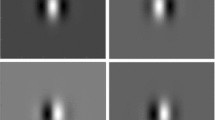Abstract
When drifting bars or gratings are used as visual stimuli, information about orientation specificity (which has a period of 180°) and direction specificity (which has a period of 360°) is inherently confounded in the response of visual cortical neurons, which have long been known to be selective for both the orientation of the stimulus and the direction of its movement. It is essential to “unconfound” or separate these two components of the response as they may respectively contribute to form and motion perception, two of the main streams of information processing in the mammalian brain. Wörgötter and Eysel (1987) recently proposed the Fourier transform technique as a method of unconfounding the two components, but their analysis was incomplete. Here we formally develop the mathematical tools for this method to calculate the peak angles, bandwidths, and relative strengths, the three most important elements of a tuning curve, of both the orientational and the directional components, based on the experimentally-recorded neuron's response polar-plot. It will be shown that, in the 1-D Fourier decomposition of the polar-plot along its angular dimension, (1) the odd harmonics contain only the directional component, while the even harmonics are contributed to by both the orientational and the directional components; (2) the phases and the amplitudes of all the harmonics are related, respectively, to the peak angle and the bandwidth of the individual component. The basic assumption used here is that the two components are linearly additive; this in turn is immediately testable by the method itself.
Similar content being viewed by others
Abbreviations
- δ(x) :
-
delta impulse function (20)
- η 0,η k :
-
coefficients of Fourier expansion of response polar-plot (15)
- ζ k :
-
coefficients of Fourier expansion of response polar-plot (15)
- λ d :
-
peak strength of the directional component (20)
- λ o :
-
peak strength of the orientational component (25)
- θ db :
-
half-bandwidth of the directional component (20)
- θ dp :
-
peak angle of the directional component (8)
- θ (k) dp :
-
value ofθ dp computed from thek-th harmonic (36)
- θ ob :
-
half-bandwidth of the orientational component (25)
- θ op :
-
peak angle of the orientational component (9)
- a 0,a k :
-
coefficients of Fourier expansion of directional component (4)
- d k :
-
coefficients of Fourier expansion of directional component (4)
- b 0,b k :
-
coefficients of Fourier expansion of orientational component (10)
- D(θ) :
-
directional component of the cell's response (2)
- O(θ) :
-
orientational component of the cell's response (2)
- R(θ) :
-
the cell's overall visual response (1)
- R(O, D) :
-
same asR(θ), merely denoting the fact thatR(θ) is composed ofO(θ) andD(θ) (1)
- Z :
-
index of linear additivity of the two omponents (35)
References
Albright TD (1984) Direction and orientation selectivity of neurons in visual area MT of the macaque. J Neurophysiol 52:1106–1130
Baker JF, Petersen SE, Newsome WT, Allman JM (1981) Visual response properties of neurons in four extrastriate visual areas of the owl monkey (Aotus trivirgarus): a quantitative comparison of the medial, dorsolateral, and middle temporal areas. J Neurophysiol 45:397–416
Berman N, Wilkes ME, Payne BR (1987) Organization of orientation and direction selectivity in areas 17 and 18 of cat cerebral cortex. J Neurophysiol 58:676–699
Daugman JG (1985) Uncertainty relation for resolution in space, spatial frequency, and orientation optimized by two-dimensional visual cortical filters. J Opt Soc Am A2:1160–1169
De Valois RL, Yund EW, Hepler N (1982) The orientation and direction selectivity of cells in macaque visual cortex. Vision Res 22:531–544
Gradshteyn IS, Ryzhik, IM (1980) Tables of Integrals, Series, and Products. Academic Press, Orlando London
Henry GH, Bishop PO, Tupper RM, Dreher B (1973) Orientation specificity and response variability of cells in the striate cortex. Vision Res 13:1771–1779
Hubel DH, Wiesel TN (1959) Receptive fields of single neurons in the cat's striate cortex. J Physiol 148:574–591
Hubel DH, Wiesel TN (1962) Receptive fields, binocular interaction and functional architecture in the cat's visual cortex. J Physiol 160:106–154
Hubel DH, Wiesel TN (1968) Receptive fields and functional architecture of monkey striate cortex. J Physiol 195:215–243
Maunsell JHR, Van Essen DC (1983) Functional properties of neurons in middle temporal visual area of the macaque monkey. I. Selectivity of stimulus direction, speed and orientation. J Neurophysiol 49:1127–1147
Mikami A, Newsome WT, Wurtz RH (1986) Motion selectivity in macaque visual cortex. I. Mechanisms of direction and speed selectivity in extrastriate area MT. J Neurophysiol 55:1308–1327
Orban GA, Kennedy H, Buller J (1986) Velocity sensitivity and direction selectivity of neurons in areas V1 and V2 of the monkey: influence of eccentricity. J Neurophysiol 56:462–480
Rose D, Blakemore C (1974) An analysis of orientation selectivity in the cat's visual cortex. Exp Brain Res 20:1–17
Schiller PH, Finlay BL, Volman SF (1976) Quantitative studies of single-cell properties of monkey straite cortex. II. Orientation specificity and ocular dominance. J Neurophysiol 39:1320–1333
Wörgötter F, Eysel U Th (1987) Quantitative determination of orientational and direction components in the response of visual cortical cells to moving stimuli. Biol Cybern 57:349–355
Zhang J, De Valois RL (1988) Uncounfounding orientation and direction components in the visual neuron's response. Soc Neurosci 14:457
Author information
Authors and Affiliations
Rights and permissions
About this article
Cite this article
Zhang, J. How to unconfound the directional and orientational information in visual neuron's response. Biol. Cybern. 63, 135–142 (1990). https://doi.org/10.1007/BF00203036
Received:
Accepted:
Issue Date:
DOI: https://doi.org/10.1007/BF00203036




